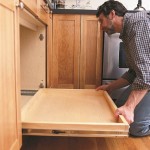Essential Aspects of Raising Kitchen Cabinets to the Ceiling
Enhancing the aesthetics and functionality of your kitchen involves consideration of several essential aspects. Raising kitchen cabinets to the ceiling offers numerous benefits, including increased storage space, creating a more spacious feel, and allowing for the seamless integration of appliances.
To ensure a successful project, it is crucial to plan meticulously and adhere to specific steps. Understanding the process's key aspects empowers you to make informed decisions and achieve the desired outcome. This article explores the fundamental elements of raising kitchen cabinets to the ceiling, providing guidance for each stage.
Essential Aspects of Raising Kitchen Cabinets to the Ceiling
1. Cabinet Type:
Determine the type of cabinets you have. Framed cabinets are constructed with a face frame that surrounds the door and drawer openings, while frameless cabinets do not have a face frame. This distinction impacts the installation process and the hardware required.
2. Ceiling Height:
Measure the ceiling height to ensure there is sufficient space to raise the cabinets. The ideal distance between the top of the cabinets and the ceiling should be between 2 and 3 inches to accommodate molding.
3. Wall Structure:
Assess the wall structure to determine its load-bearing capacity. If the wall is not strong enough to support the weight of the raised cabinets, additional support, such as a ledger board, may be necessary.
4. Cabinet Placement:
Plan the placement of the cabinets carefully, considering the layout and the available space. Adjust the cabinet height to align with the ceiling and ensure a level installation.
5. Fastening Method:
Choose the appropriate fastening method to secure the cabinets to the ceiling. Depending on the cabinet type and wall structure, you may use screws, nails, or clips.
6. Trim and Moldings:
Install trim and moldings around the top and sides of the cabinets to conceal gaps and enhance the overall design. Crown molding is a popular choice for a decorative touch.
Conclusion:
Raising kitchen cabinets to the ceiling involves a comprehensive approach that considers various essential aspects. From determining cabinet type to ensuring proper wall support, each step plays a vital role in achieving a successful and visually appealing result. Understanding these fundamental elements empowers you to plan effectively and navigate the installation process with confidence.

Genius Diy Raising Kitchen Cabinets And Adding An Open Shelf The Crazy Craft Lady

Raised Kitchen Cabinet Makeover Sawdust 2 Stitches

Simple Kitchen Upgrade Raise Your Cabinets To The Ceiling Old Barn

How To Raise Your Kitchen Cabinets The Ceiling Wildfire Interiors

Raised Kitchen Cabinet Makeover Sawdust 2 Stitches

How To Raise Your Kitchen Cabinets The Ceiling Wildfire Interiors

How To Raise Your Kitchen Cabinets The Ceiling Wildfire Interiors

Extending Kitchen Cabinets To Ceiling American Wood Reface

Diy Extending Kitchen Cabinets To The Ceiling On A Budget Tiny Hands Tidy Home

Raised Kitchen Cabinet Makeover Sawdust 2 Stitches
Related Posts








